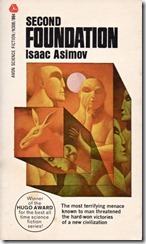 Second Foundation concludes Isaac Asimov's classic Foundation Trilogy
Second Foundation concludes Isaac Asimov's classic Foundation Trilogy
The Mule has taken over much of the galaxy defeating The Foundation and establishing his own empire through the use of his powerful mutant mental powers. He has spent years searching for the hidden Second Foundation established by the psychohistorian Hari Seldon centuries earlier, correctly assuming it is the only viable threat to his reign. But the Second Foundation finds him before he can find it and they have similar - if less powerful mental powers.
The Mule cannot last forever, and he leaves no heir (which is why he is "The Mule"), but he did leave Seldon's plan in shambles by so drastically altering the history of the universe in an unpredictable way.
The second half of this book chronicles the Second Foundation's efforts to rebuild Seldon's plan and set the galaxy back on a path toward a second galactic empire. It features a war between The Mule's successors and the remnants of The Foundation and The Foundation's quest to locate the Second Foundation.
Asimov uses his talent for misdirection multiple times in this book, guiding the reader toward one conclusion and then another, before revealing the true answer. He does this most when identifying who is with the Second Foundation and where it is located.
This volume brings to the fore a theme that lurked under the surface of the first two books: The people of the Foundation know that Seldon's plan almost guarantees their success. They have almost a religious faith in their eventual victory. This helps boost morale during the war, but hinders them as they work to overcome other obstacles. They know that the actions of individuals are insignificant in Seldon's plan and that Seldon's plan predicts their ultimate triumph. So how much effort need they put forth in accomplishing the inevitable? They hold these beliefs even after the disruption of the plan by the actions of the Mule.
One thing that appealed to me about this series is that the principles of using large amounts of data to do predictive analysis has become a huge field of study today. Machine Learning and Big Data are fields that existed since the days of Asimov, but now that cloud computing provides massive compute power at affordable prices, these sciences have gained both power and interest. Asimov foresaw this 50 years ago.
Later in his life, Asimov returned to writing about the Foundation; but this trilogy began the ideas and remains one of his strongest work. It is well worth reading.